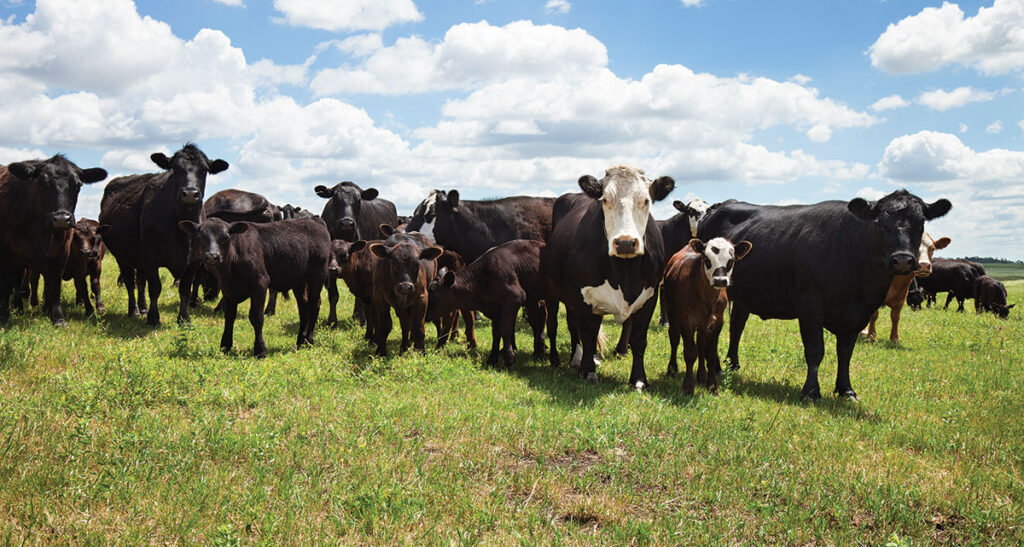
Increasing pounds on calves
Improving the rate of gain in calves requires a balanced approach. Before taking any action, first look to determine if the calves are getting the basic building blocks to put on pounds.
“Increasing performance on growing calves depends on the protein and energy supplied through their diet, the macro and trace minerals available, and the efficiency of the calf,” Paul Beck, Ph.D., livestock specialist with Oklahoma State University, said.
Adding Inputs: Beck adds if producers are providing sufficient protein and energy to calves, it can be inefficient and expensive to add more through supplementation. For example, research indicates providing additional energy supplementation can come at the cost of 9 to 10 pounds of feed per pound of added gain, or more.
However, livestock specialists state if nutrients are limiting growth, supplementation can be efficient and cost effective. According to Beck, research conducted at the Oklahoma State University (OSU) Eastern Research Station analyzed the rate of gain of calves fed 2.7 pounds of dried distillers grain cubes every day throughout the summer. The calves, which were grazing Bermudagrass pastures, increased gains of .5 pounds a day, but they required 5.4 pounds of supplement per added pound of grain.
Beck states in a similar trial in Arkansas, feeding 2.5 pounds per day of the distillers grain cubes increased gains during the late summer by 0.94 pounds (which is the difference of 1.26 pounds for unsupplemented calves and 2.2 pounds for supplemented calves). This study revealed it required only 2.7 pounds of supplement per pound of added gain.
In the Arkansas trial, some other calves were fed a free-choice molasses lick tub either all summer or only during the late summer. “Using the self-fed supplement increased gains during the late summer by 0.2 pounds per day, but the cost per pound of added gains was over $8.00 per pound,” Beck explained. “For supplementation to be cost effective the right supplement must be fed at the right price.”
Creep feeding: Producers may want to consider several factors before deciding whether creep feeding makes sense for their operation. According to livestock specialists, when adequate grass and milk are available for calves, many times it requires 9 to 10 pounds of creep per pound of added gain.
However, a scaled down approach may produce more benefits. “A limit fed creep supplement fed at 2 to 3 pounds per day has been shown to increase gains by 0.5 to 0.7 pounds per day, when fed during the late summer and provides additional protein and energy to the calf,” Beck added.
Providing Minerals: The right amount of minerals can help give calves an added boost in weight and overall health. “Research in Oklahoma and Arkansas showed that gains of calves grazing wheat pasture were increased by 0.2 to 0.5 pounds per day when they were provided a free-choice complete mineral compared with only a white salt block,” Beck shared.
Implanting calves: Numerous research trials reveal implanting calves with a growth stimulant will improve their rate of gain. Implants can be an economically feasible practice for many producers. “Implants function by increasing muscle growth and reducing fat deposition, decreasing physiological maturity and thereby increasing growth potential and efficiency of nutrient utilization,” Beck said.
According to Beck, implanting calves at 3 to 4 months of age increases calf weaning weights by an average of 25 pounds at 6 to 7 months of age. This outcome means for each dollar producers invest; they receive a return of $25.00 to $30.00. In addition, research indicates implanting stocker calves increases average daily gain by 0.3 to 0.4 pounds per day increasing sales weight by 40 to 60 pounds.
Implanting calves is a viable option for many producers. “Implanting increases gains and is a safe way to economically increase production and reduce the economic and environmental costs of production,” Beck stated.
Livestock specialists state implanting steers, regardless of age, increases weight with no reduction in performance. Females receiving a single implant at 3 to 4 months of age will have an increased weaning weight, with no detrimental effects on later reproduction. However, implanting a heifer at birth or administering a second implant postweaning may have detrimental affects on her reproduction.
Ionophores: Ionophores are another option for producers looking to increase their calves’ rate of gain. Ionophores are feed additives used to increase feed efficiency and weight gain. “Ionophores work by increasing the efficiency of digestion and metabolism in the rumen, reducing the carbon footprint of livestock production,” Beck explained.
Watching Costs: Regardless of what avenue producers decide to take they should be mindful of the expense associated with adding gain to growing calves. Implants and ionophores may be the most cost effective. “Supplementation programs must be investigated to ensure they are providing the right supplements and are at the right cost for the expected improvement in performance,” Beck added.






